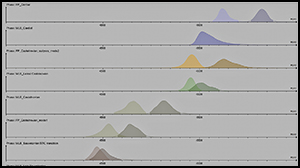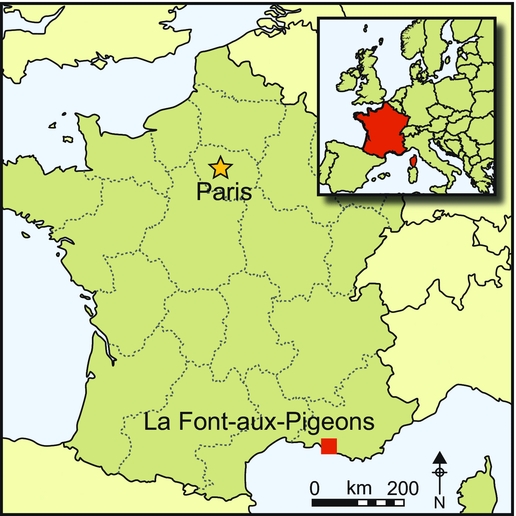
Mesolithic vs Neolithic interaction in the western Mediterranean
The spread of early farming in Western Europe is currently understood to have resulted from successive movements of people starting at the beginning of the seventh millennium BC in the Near East and Anatolia (Guilaine Reference Guilaine2001). A common Aegean origin for the European Neolithic is supported by recent research on the ancient human genome (Hofmanová et al. Reference Hofmanová, Kreutzer, Hellenthal, Sell, Diekmann, Díez-del-Molino, van Dorp, López, Kousathanas, Link, Kirsanow, Cassidy, Martiniano, Strobel, Scheu, Kotsakis, Halstead, Triantaphyllou, Kyparissi-Apostolika, Urem-Kotsou, Ziota, Adaktylou, Gopalan, Bobo, Winkelbach, Blöcher, Unterländer, Leuenberger, Çilingiroğlu, Horejs, Gerritsen, Shennan, Bradley, Currat, Veeramah, Wegmann, Thomas, Papageorgopoulou and Burger2016). From the Aegean, where the Neolithic is evidenced from at least c. 6500 BC, movement of people is well known (Childe Reference Childe1925) to have followed two main routes: i) to the north through the Central Balkans and the Danube Valley, at the origin of the Starčevo-Körös-Criş Complex and further Linearbandkeramik (LBK) Complex; and ii) to the west across the Mediterranean, at the origin of the Western Impressed-ware or Impresso-Cardial Complex (ICC).
Western ICC spatial distribution and the short interval between the earliest evidence for farming settlements in south-eastern Italy and on the north-western Mediterranean coasts support the idea of leapfrog-like movements of pioneers: starting from Apulia and Dalmatia in c. 6000 BC (Tiné Reference Tiné2009; Forenbaher et al. Reference Forenbaher, Kaiser and Miracle2013), reaching Liguria, Provence and Languedoc in c. 5800 BC (Binder & Maggi Reference Binder and Maggi2001; Guilaine et al. Reference Guilaine, Manen and Vigne2007) and, later, the Levante in c. 5600 BC (Zilhão Reference Zilhão2001). In addition, the appearance of obsidian from Palmarolla and Sardinia within the earliest north-western Neolithic contexts (as seen at most of the earliest Apulian and Calabrian sites with obsidian from Lipari) demonstrates seafaring (Ammerman Reference Ammerman, Anderson, Barrett and Boyle2010; Binder et al. Reference Binder, Gratuze, Vaquer, Borrel, Borrel, Bosc, Clop and Molist2012).
Regardless of their variability and short-term evolution, which is the topic of ongoing research, the earliest features of the north-western ICC (i.e. the Impressa phase) during the first half of the sixth millennium BC exhibit stylistic aspects that can be connected to south-eastern Italy, albeit to specific changes in the material culture that raise the question of cultural drift and admixture. They pre-date and differ from the Franco-Iberian Cardial style, which itself corresponds to the period when the ICC was fully developed during the second half of the sixth millennium BC (Binder Reference Binder and Voruz1995, Reference Binder and Price2000; Guilaine et al. Reference Guilaine, Manen and Vigne2007; Binder & Sénépart Reference Binder, Sénépart, Manen, Convertini, Binder and Sénépart2010).
There are major uncertainties, however, concerning the route taken across the Mediterranean and social interactions during the colonisation of the north-western Mediterranean basin. Indeed, the available Neolithic DNA is rare and is too late (i.e. second half of the sixth millennium (Gamba et al. Reference Gamba, Fernandez, Tirado, Deguilloux, Pemonge, Utrilla, Edo, Molist Montaña, Rasteiro, Chikhi and Arroyo-Pardo2011)) compared to the earliest evidence of farming in southern Italy at the beginning of the sixth millennium BC. This timespan allowed for diverse forms of biological admixture and cultural syncretism between the Neolithic groups and those that still belonged to the Late Mesolithic (the Blade and Trapeze Mesolithic Complex—BTC) and its regional aspect (the Castelnovian). Despite uncertainty around the origins of the BTC and questions about the role it could have played in southern Italy in changing some aspects of the Aegean Neolithic package, current research concerns its role in the transition period, from the early seventh millennium BC to the fifth millennium BC in Western Europe, and the generalization of Western European farming settlements (Binder Reference Binder, Perrin, Manen, Marchand, Allard, Binder and Ilett2013; Perrin & Binder Reference Perrin, Binder, Manen, Perrin and Guilaine2014; Marchand & Perrin Reference Marchand and Perrin2017). The early western Neolithic discontinuous settlement pattern and radiocarbon dates suggest that the first farmers bypassed regions where BTC hunter-gatherers were still located. This hypothesis, first addressed in the Spanish Levant (Garcia Puchol Reference Garcia Puchol2005), and formerly known as the Dual Model, is relatively well supported by data in the northern Adriatic, the Po Plain and the Tuscano-Emilian Apennines. It is, however, still poorly documented in the Rhône Valley and the French Alps, where several Castelnovian sites are known (Binder Reference Binder, Perrin, Manen, Marchand, Allard, Binder and Ilett2013; Perrin & Binder Reference Perrin, Binder, Manen, Perrin and Guilaine2014; Marchand & Perrin Reference Marchand and Perrin2017). Here, sites that reveal ICC Neolithic occupation overlying BTC Mesolithic layers are scarce. This presents a particular challenge, as such sequences are crucial for understanding the transition at the western Mediterranean scale (Figure 1). To date, only four such sites (Montclus – La Baume; Sassenage – La Grande Rivoire; Dos Aguas – Cocina; Alcoi – Falguera) have benefited from AMS dating of short-lived material and the resulting relevant chronologies (Garcia Puchol & Aura Tortosa Reference Garcia Puchol and Aura Tortosa2006; Perrin et al. Reference Perrin, Marchand, Allard and Binder2010).
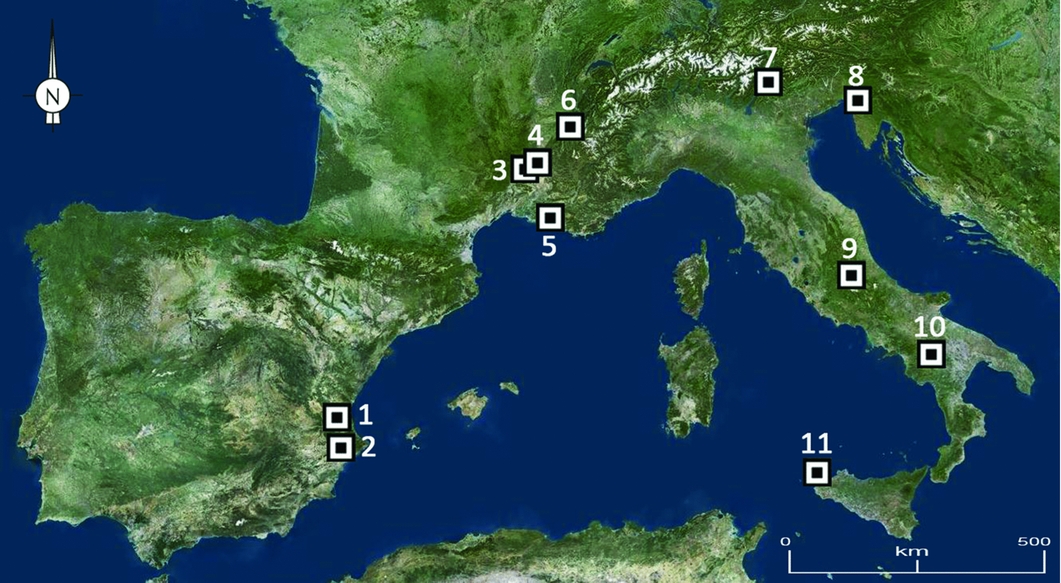
Figure 1. Châteauneuf-lès-Martigues – La Font-aux-Pigeons rockshelter (5): location relative to the main Mesolithic Blade and Trapeze Complex (BTC) and Neolithic Impresso-cardial Complex (ICC) stratified sites in the western Mediterranean. 1) Dos Aguas – Cueva de la Cocina; 2) Alcoi – Abric de la Falguera; 3) Montclus – La Baume; 4) Espeluche – Lalo; 6) Sassenages – La Grande Rivoire; 7) Trento – Riparo Gaban; 8) Aurisina – Grotta de l'Edera; 9) L'Aquila – Grotta Continenza; 10) Potenza – Grotta Latronico 3; 11) Trapani – Grotta de l'Uzzo.
The site of Châteauneuf-lès-Martigues – La Font-aux-Pigeons has played a singular role in European Neolithic studies (Guilaine Reference Guilaine and Evin2007). Detailed stratigraphic dating (Courtin et al. Reference Courtin, Evin and Thommeret1985) has enabled analysis of the transition from Mesolithic to Neolithic settlement, and proposes questions concerning interaction and admixture. Comparison of the new results with those from the nearby site of Montclus – La Baume, which provides a comparable chronology, is especially significant; the latter also played a key role in the theory of the Neolithic transition in the western Mediterranean (Escalon de Fonton Reference Escalon de Fonton1971; Rozoy Reference Rozoy1978) and has also recently yielded short-life AMS dates (Perrin et al. Reference Perrin, Marchand, Allard and Binder2010).
La Font-aux-Pigeons and the Neolithic transition in the western Mediterranean
La Font-aux-Pigeons rockshelter at Châteauneuf-lès-Martigues, on the southern bank of the Étang de Berre (Berre Lagoon) (Figure 1), is well known as a key stratified site in southern France, where Max Escalon de Fonton carried out his pioneering work in the 1950s on the nature of the Neolithic transition in the western Mediterranean. He defined an original Mesolithic ‘Castelnovian’ phase (stratigraphic units F8 to C7) which he believed to be the origin of the subsequent ‘Cardial’ phase (stratigraphic units F6 to F1)—in other words, the western Mediterranean ‘Early Neolithic’. Escalon de Fonton consequently designated the earliest Cardial pottery assemblage from this site as the archetype for the earliest western Mediterranean Impressed Wares (Escalon de Fonton Reference Escalon de Fonton1956). Identification of domestic sheep remains within the Mesolithic deposits supported the hypothesis of an indigenous process of Mesolithic–Neolithic transition, which occurred independent of the Near Eastern core (Ducos Reference Ducos1958; Escalon de Fonton Reference Escalon de Fonton1971; Guilaine Reference Guilaine1976).
Jean Courtin carried out a rescue excavation in 1979, following the destruction of part of the site (Courtin et al. Reference Courtin, Evin and Thommeret1985). Resulting biological and cultural data allowed for a reassessment of Escalon de Fonton's interpretations. Sheep remains were, in fact, lacking from Mesolithic deposits, appearing in the earliest pottery phase alongside evidence for goats, cattle, wheat and barley. Furthermore, dramatic changes within the material culture and environmental evidence were recorded (see Courtin et al. Reference Courtin, Evin and Thommeret1985; and, for example, Binder Reference Binder1987; Binder & Courtin Reference Binder, Courtin, Guilaine, Courtin, Roudil and Vernet1987; Vernet et al. Reference Vernet, Thiébault, Heinz, Guilaine, Courtin, Roudil and Vernet1987). Nevertheless, the identification of cereal grains within the Mesolithic deposits (Marinval Reference Marinval1988) raised questions about the nature of the Castelnovian, its economic basis and its possible links with the as yet unknown first farmers.
A set of 31 radiocarbon dates from La Font-aux-Pigeons has been assembled since the 1960s. Courtin et al. (Reference Courtin, Evin and Thommeret1985) published an initial synthesis just prior to major methodological improvements in radiocarbon dating in the form of AMS. These dates were often associated with large standard errors (5 exceed 200 years, and 22 are between 100 and 200 years). Four dates, with standard errors of less than 100 years, correspond to Cologne laboratory measurements that were recalculated in the 1980s (Courtin et al. Reference Courtin, Evin and Thommeret1985). This resulted in a very poor level of dating accuracy for the sequence, following calibration. Moreover, little consideration was given at the time to the suitability of the material sampled for dating, and none of the charcoal fragments dated during the 1980s had been taxonomically identified beforehand. The presence of local slow-growing and long-lived species (Vernet et al. Reference Vernet, Thiébault, Heinz, Guilaine, Courtin, Roudil and Vernet1987), such as Juniperus sp.—which can present small diameters even when centuries old (Kuniholm & Newton Reference Kuniholm, Newton, Gérard and Thissen2002)—and Quercus sp., increased the risk of bias induced by an old-wood effect (Waterbolk Reference Waterbolk, Aurenche, Evin and Hours1987). Four dates were obtained from marine shells. Their suitability for dating this sequence has already been criticised due to geochemical conditions on the site (Courtin et al. Reference Courtin, Evin and Thommeret1985: 550–51). Progressive marine submersion of the Étang de Berre during the Early Holocene (Courtin et al. Reference Courtin, Evin and Thommeret1985; Provansal et al. Reference Provansal, Arnaud, Vella, Oberlin and Sistach1998) may have significantly modified shell isotopic ratios from the Mesolithic and Neolithic levels (see, for example, Fernandes Reference Fernandes2014). The local reservoir effect cannot be accurately evaluated, owing to the absence of consistent references.
Using the available data, Courtin et al. (Reference Courtin, Evin and Thommeret1985) proposed to place the end of the Castelnovian at around 5600 BC, the emergence of the Early Cardial at between 6200 and 5800 BC, and the end of the Cardial at the site at around 4600 BC. Their interpretation thus supported the idea of a continuous stratigraphic sequence at La Font-aux-Pigeons and of the precocity of the Cardial pottery phase.
Additional AMS dates: samples, methods and results
We here provide a new set of 13 AMS dates (Table 1) in response to the questionable dates (Binder & Guilaine Reference Binder, Guilaine, Evin, Oberlin, Daugas and Salles1999; Manen & Sabatier Reference Manen and Sabatier2003) provided by Courtin and recent controversial AMS dating of the upper Castelnovian levels (Perrin et al. forthcoming). The aim was to specify dates for and duration of the eponymous Castelnovian phase (US.19B–18A) and of the Cardial phase (US.17–8), and to test an alternative stratigraphic hypothesis: the existence of a gap between the Mesolithic and Neolithic deposits. Indeed, a continuous occupation of the site should have provided earliest aspects of ICC (Impressa), which are well known to the east (Eastern Provence and Liguria; Binder & Maggi Reference Binder and Maggi2001) and west (Hérault district; Guilaine et al. Reference Guilaine, Manen and Vigne2007).
Table 1. New AMS dates from J. Courtin's sampling at Châteauneuf-lès-Martigues – La Font-aux-Pigeons (FP) (except Beta-267434, from Perrin et al. forthcoming) and from M. Escalon de Fonton's excavations sampling at Montclus – La Baume (MLB) (from Perrin et al. Reference Perrin, Marchand, Allard and Binder2010).
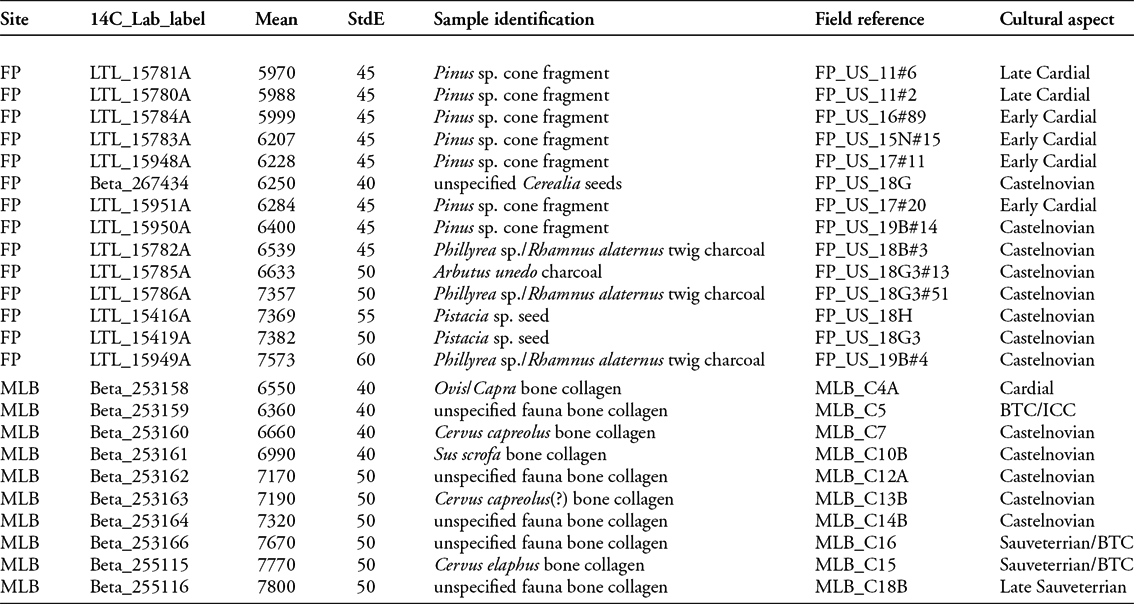
Sample selection
The material selected for dating from La Font-aux-Pigeons (Table 1) consisted of single charred seeds sampled from the series studied by P. Marinval (Reference Marinval1988) and single pieces of charcoal or charred pine cones selected during J. Battentiers's ongoing anthracological analysis of the site. The charcoal fragments are identified as short-life specimens. When available, pine cones (annual) were preferred to pine wood (perennial).
Following the stratigraphy described by Courtin et al. (Reference Courtin, Evin and Thommeret1985), the samples for dating are distributed as outlined below, from the bottom upwards (the relative wood species abundances in the spectra refer to unpublished data from J. Battentier):
-
• At the base of the Castelnovian occupation (US.19C–19A): from US.19B, a burnt twig from Phillyrea sp./Rhamnus alaternus and a fragment of Pinus sp. cone. Within layer 19, Phillyrea sp./Rhamnus alaternus represents 46% of the assemblage (58% for 19B), while pine tree (mainly P. halepensis/pinaster/pinea) represents 3% (5% for US.19B).
-
• At the top of the Castelnovian occupation (US.18H–18A): two seeds of Pistacia sp., which represents the main fruit collected within Mesolithic layers from US.18H and US.18G3; two fragments of Phillyrea sp./Rhamnus alaternus, including the last rings and bark (distinctive for the wood formed just before harvest) from US.18G3 and US.18B and a fragment of Arbutus unedo from US.18G3. Phillyrea sp./Rhamnus alaternus represents 29% of the assemblage from layer 18 (50% in US.18G3), while Arbutus unedo represents 1% (3% in US.18G3). From this set (US.18G), domestic Cerealia seeds provided a new AMS date (Perrin et al. forthcoming), which is included in the following modelling.
-
• At the base of the Cardial occupation (US.17–15): four Pinus sp. cone fragments (two from US.17, one from US.16 and one from US.15N). Pine tree represents 38–52% of the assemblage from these layers.
-
• At the top of the Cardial occupation (US. 14–8): two Pinus sp. cone fragments from US.11. Pine tree represents 24–68% of the assemblage from these layers, with a maximum in US.8a.
Dating methods and results
New radiocarbon measurements were performed at the Centro di Datazione e Diagnostica (CEDAD—Università del Salento, Lecce, Italy), following international standards for sample cleaning and purification, 13C correction and final error calculation. The conventional BP results (Table 1) suggest the following:
The range of six conventional dates from the Cardial deposits is 6284±45 BP at the earliest, and 5870±45 BP at the latest. One date (LTL-15784A) from the Early Cardial level differs from the other three, and could match those from the Late Cardial (US.11). This may be evidence of small vertical movements of ecofacts and artefacts through the sediment (within the Cardial phase) without affecting the whole picture.
Distribution of the eight conventional dates from the Castelnovian layers is bimodal, with four dates between 7573±60 and 7357±50 BP (cluster 1), and four dates between 6400±45 and 6250±40 BP (cluster 2), while the earliest Castelnovian deposits provide indistinctly early and late dates. Within the younger cluster 2, it is noticeable that the date from the very bottom of the sequence (US.19B) was from the only pine cone fragment discovered within the Mesolithic deposits. In contrast, most of the pine cone fragments (28 of the 29 specimens discovered so far) come from the Cardial levels. A similar, very late date from the top of the Mesolithic sequence (US.18G: Beta-267434) was obtained from Cerealia seed, which was recovered in great quantities from the Cardial deposits (Perrin et al. forthcoming). This clearly indicates that the younger cluster of dates is not relevant within a Mesolithic context, and exemplifies Neolithic contamination throughout the Castelnovian deposits. Thus, the authors consider these outlying dates (Castelnovian cluster 2) separately in subsequent modelling (Hypothesis B).
The evidence for significant intra-sedimentary vertical movements at La Font-aux-Pigeons is unsurprising, as a very late outlying date had been previously obtained for the beginning of the Mesolithic (US.19, Ly-2831, 6720±140 BP, Courtin et al. Reference Courtin, Evin and Thommeret1985). It is currently impossible to determine whether such movements occurred during site formation processes (e.g. unclear Neolithic pits, percolation within the gravel deposits, earthworm bioturbation, or burrows), or whether they could have resulted from contamination during fieldwork, despite the very careful excavation and sampling methods employed. Such post-depositional processes and difficulty in identifying precise contours for geoarchaeological features are common within caves and rockshelter contexts (Villa & Courtin Reference Villa and Courtin1983).
Bayesian modelling
Methods
Calibrations and Bayesian modelling were performed with ChronoModel® software, version 1.5.0 (Lanos & Philippe Reference Lanos and Philippe2015a & Reference Lanos and Philippeb; Lanos et al. Reference Lanos, Philippe, Lanos and Dufresne2015), using the IntCal13 14C curve (Reimer et al. Reference Reimer, Bard, Bayliss, Beck, Blackwell, Bronk Ramsey, Buck, Cheng, Edwards, Friedrich, Grootes, Guilderson, Haflidason, Hajdas, Hatté, Heaton, Hoffmann, Hogg, Hughen, Kaiser, Kromer, Manning, Niu, Reimer, Richards, Scott, Southon, Staff, Turney and van der Plicht2013). All calibrated dates are given as BC.
The set of AMS dates from La Font-aux-Pigeons was initially clustered within nine successive ‘events’ corresponding to the smallest dated stratigraphic units recorded during the excavation, on the basis of a contemporaneity hypothesis. For the Bayesian modelling, stratigraphic constraints were only applied to the events. Thus, five events constitute the Castelnovian phase (from the bottom up: US.19B to 18B) and four further events define the Cardial phase (from the bottom up: US.17 to 11) (Table 1).
Two models have been constructed (Figure 2):
-
• Hypothesis A takes into account the whole set of 14 dates, strictly following the Bayesian paradigm.
-
• Hypothesis B considers the four younger dates from the Castelnovian deposits in a specific ‘outlying’ cluster, as single events, without applying any stratigraphic constraint.
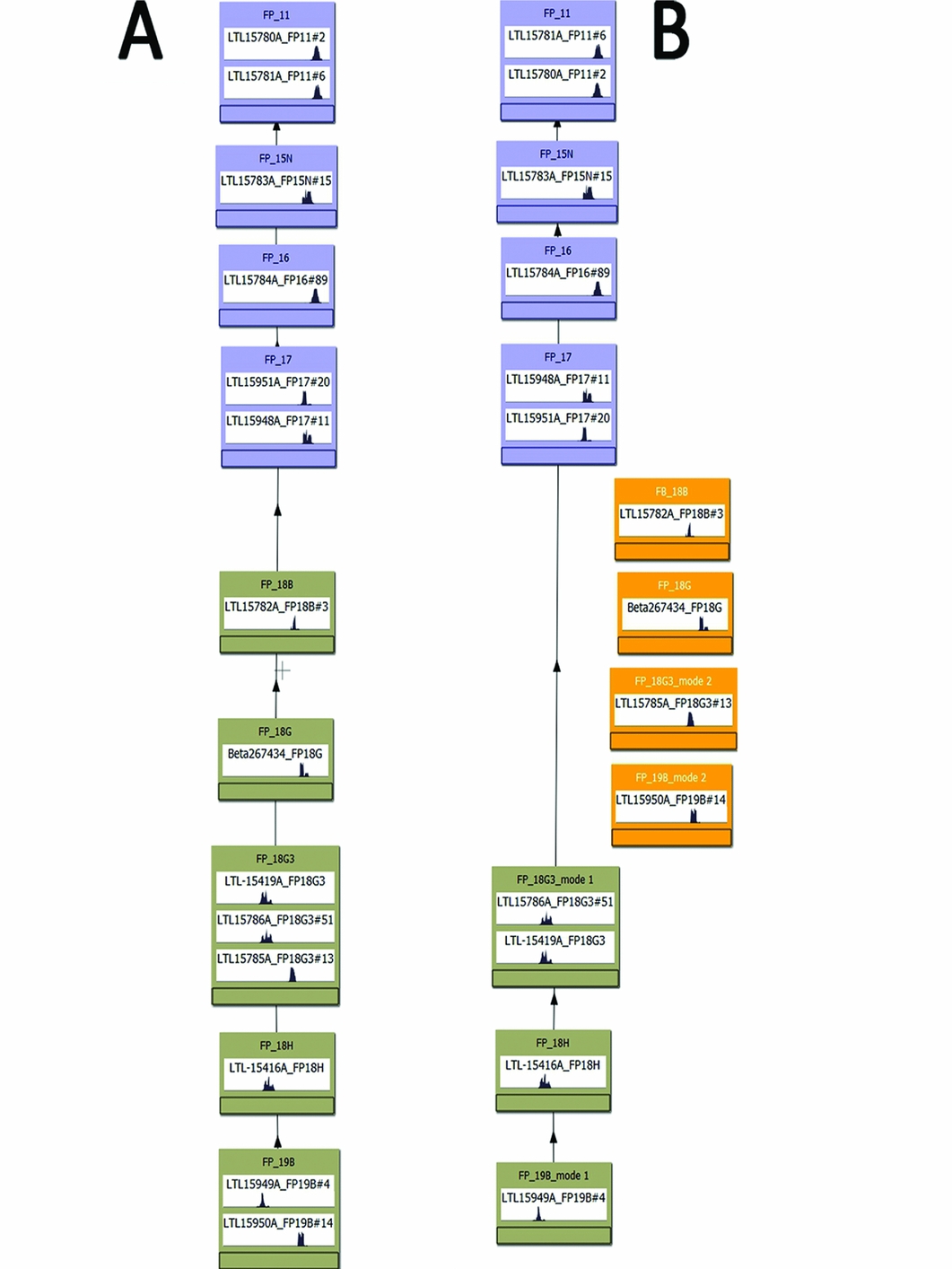
Figure 2. Bayesian modelling of La Font-aux-Pigeons stratigraphy, using ChronoModel® 1.5.0 (hypotheses A and B). Events are represented by boxes, data are listed inside (blue boxes: ICC events and phase; grey boxes: BTC events and phase; orange boxes: ‘outlying’ events and phase).
Modelled dates
Results explained in Table S1 use the following parameters: highest posterior density interval at 95% (HPD), posterior mode (MAP), mean and standard deviation (StdD) of the posterior density (Figures 3 & 4; Table S1a–d in online supplementary material). Credibility intervals for single dates are calculated using ChronoModel®.

Figure 3. La Font-aux-Pigeons: posterior density distribution of the events of each model. The lines above the curve represent the shortest 95% credible interval. The 95% highest posterior density regions are represented by the area under the curves: A) including all measurements; B) isolating outlying cluster. The position of intrusive cereal into the Castelnovian layer 18G is highlighted in red.
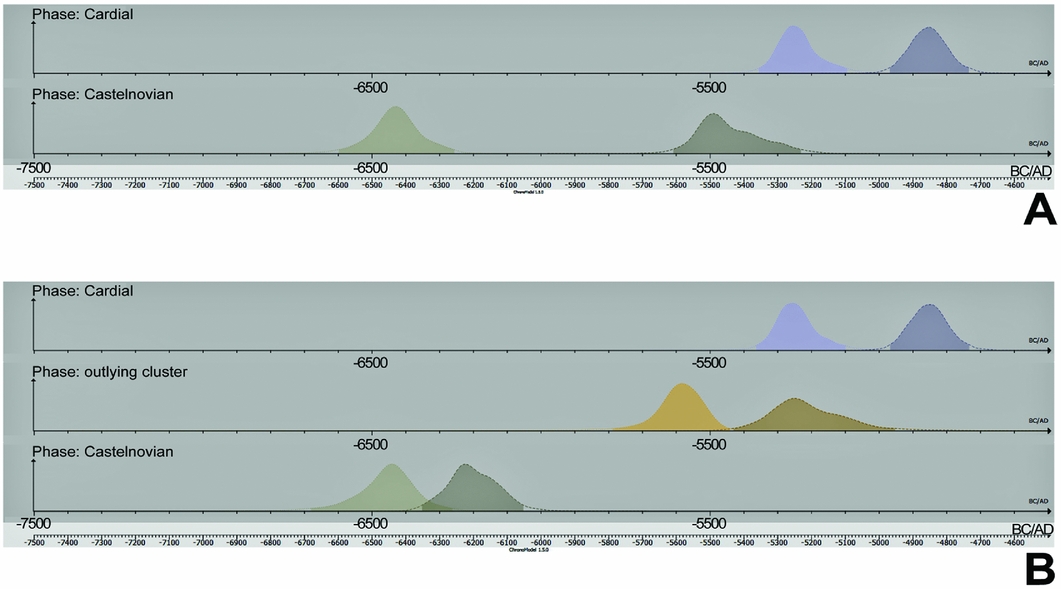
Figure 4. La Font-aux-Pigeons: posterior density distribution of the beginning and the end of all phases following hypotheses A and B. The density region of the beginning of the phase is the oldest. The density region of the end of the phase is the most recent one. The 95% highest posterior density regions are presented by the area under the curves.
Modelled boundaries for the Cardial phase at La Font-aux-Pigeons are similar, regardless of the hypothesis selected: starting at 5240±64 (A) or 5245±65 (B) BC and finishing at 4854±59 (A) or 4853±59 BC (B), with durations estimated at 386±86 (A) or 392±87 years (B). Thus, considering the available data, the probability of the in situ Cardial phase at La Font-aux-Pigeons beginning before 5364 BC is almost zero. The subdivision of the Cardial phase into sub phases (i.e. Early Cardial US.17–15 vs Late Cardial US.11 at the site) will require additional dates for the upper Cardial levels (US.14–8) and for the Postcardial deposits (US.7–1).
The Castelnovian phase at La Font-aux-Pigeons may have begun at 6434±88 (hypothesis A) or 6467±115 BC (B); the probability of its starting before 6681 BC is almost zero. The estimated duration of this phase depends on the modelling hypotheses: 991±132 (A) or 266±133 (B) years. According to hypothesis A, the Castelnovian phase could have finished around 5442±98 BC and may even have overlapped the Cardial phase for a brief period. According to hypothesis B, the end of the Castelnovian phase could be dated to 6200±78 BC, suggesting a large gap (of at least 970 years) between the Mesolithic and preserved Neolithic occupations.
The chronological range for the cluster of outlying dates from the Mesolithic deposits differs from the in situ Cardial phase, and from that of the earliest dated Cardial event. This cluster starts at 5604±118 BC, at least 640 years after the end of the Castelnovian phase, and ends at 5205±125 BC when in situ Cardial deposits are supposed to begin. This could indicate that part of the sample belonged to an earlier Neolithic occupation.
Part of the gap between the Mesolithic and Neolithic at the site could then be attributed to destructive events occurring before the Cardial phase. The scant remains of the eroded deposits may have subsequently contaminated the earlier Mesolithic deposits. The dates suggest that erosive episodes of the abrupt 8.2 kY climatic event (observed in particular in the Middle Rhône Valley: Berger et al. Reference Berger, Delhon, Bonté, Thiébault, Peyric, Beeching, Vital, Bravard and Magny2002) cannot be at the origin of any disturbance. Such truncation is more likely to have occurred around 5400–5300 BC, a period characterised by major flooding episodes in the region (Berger Reference Berger and Guilaine2005). Consequences of flooding could have been especially severe for a site whose topography is described as resembling a trough (Escalon de Fonton Reference Escalon de Fonton1956; Courtin et al. Reference Courtin, Evin and Thommeret1985).
Montclus – La Baume modelling
Modelling of ten AMS dates from Montclus – La Baume (from Perrin et al. Reference Perrin, Marchand, Allard and Binder2010) was performed in the same way as for the Font-aux-Pigeons series (Figure 5; Table S1e–f). Montclus – La Baume yielded thick stratified deposits spanning the period from the eighth to the sixth millennia BC. From the bottom up, it includes the following levels: Late Sauveterrian (US.22–7); transitional levels (US.15–16) to Castelnovian deposits (US.14–8); latest BTC levels, where the ‘Montclus’ arrowheads first appear (US.7–5); Cardial deposits (US.4–3); and then later Neolithic occupation layers associated with the Chassey culture (US.2). The cultural attribution of both transitional series (US.15–16; US.7–5) is still a matter for debate.

Figure 5. La Font-aux-Pigeons (hypothesis B) and Montclus – La Baume: compared posterior distribution results of the modelled BTC Mesolithic and ICC Neolithic phases.
Results suggest a short transitional phase at the end of the Sauveterrian cycle (from 6558±61 to 6508±83 BC), associated with the earliest appearance of trapezoidal microliths. Some of these trapezes, which are symmetrical and shaped on twisted blanks without using the microburin technique, were previously taken as evidence for the existence of a specific stage (i.e. ‘Sauveterrien à trapèzes’), distinct from the Castelnovian in the strict sense of the term (Rozoy Reference Rozoy1978). At Monctlus, the modelled phase of the Castelnovian starts around 6207±88 BC, which corresponds to the end of the modelled Castelnovian phase at La Font-aux-Pigeons (following hypothesis B); it finishes, at the earliest, around 5860±81 BC, or even around 5460±87 BC, if stratigraphic units 7 to 5 belong to the same cultural sequence. The modelled interval of the Neolithic date from Montclus US.4A (obtained from a sheep or goat bone) is constrained by the date obtained for the underlying aceramic layer US.5, and lies between 5588 and 5076 BC (HPD). It is not, in fact, sufficiently accurate to define the chronological position of the related US.4A deposits.
Discussion and conclusions
This study initially confirms the chronological complementarity of the Mesolithic BTC occupations at Châteauneuf-lès-Martigues – La Font-aux-Pigeons and Montclus – La Baume, as previously described by Rozoy (Reference Rozoy1978) on the basis of typological analysis of lithic industry. Regardless, this challenges the question of earliest trapezes at Montclus (US.16–15)—a first stage of the Castelnovian—recognised at La Font-aux-Pigeons (US.19B–18G) between 6442 and 6225 BC (MAP) and a second stage at Montclus – La Baume (US. 14–8), between 6194 and 5874 BC. Although the corresponding transition fits with the ‘8.2 kY event’, there is insufficient detail from either site (in terms of site formation processes and taphonomy) to support the idea that climate influenced a change in Mesolithic territorial patterning.
As demonstrated above, the Cardial occupation of La Font-aux-Pigeons, dating probably from 5255 to 4850 BC (MAP) and certainly after 5370 BC (upper boundary of the confidence interval), fell at a late stage in regard to the ICC periodisation, and even the Cardial periodisation itself. Earlier dates on short-lived material are known for the Cardial pottery style in neighbouring regions (e.g. Le Garn – Oullins, layer 6: ETH-27972, 6510±60 BP, HPD 5720–5200 BC and ETH-27975, 6360±60 BP, HPD 5631–5055 BC; van Willigen et al. Reference van Willigen, Hajdas and Bonani2009); farther east in Eastern Provence (e.g. Castellar – Pendimoun, burials H2, F1 and F2: GrA-32061, 26893 and 26894, 6450±40, 6440±40 and 6445±40 BP, HPD 5484–5338, 5482–5335 and 5480–5333 BC; Cavalaire – Centre-Ville, FO1012, Poz-23393 and Poz-23392, 6470±40 and 6450±40 BP, HPD 5498–5347 and 5474–5324 BC; Binder & Sénépart Reference Binder, Sénépart, Manen, Convertini, Binder and Sénépart2010); and to the west in Spain (e.g. Teulada – Cova de les Cendres, H16, GifA-101360, 6490±90 BP, HPD 5616–5305 BC; Bernabeu Auban & Molina Balaguer Reference Bernabeu Auban and Molina Balaguer2009). This is surprising because the La Font-aux-Pigeons series was originally considered the archetype of the very first western Mediterranean pottery (Escalon de Fonton Reference Escalon de Fonton1956; Guilaine Reference Guilaine1976) and, later, as the origin of the Franco-Iberian Cardial style (Manen Reference Manen2002). Indeed, outlying dates from the site could refer to a Neolithic event pre-dating the in situ Cardial deposits. Such a hypothesis, however, remains speculative, due to a dearth of consistent artefactual evidence.
The new dates confirm and extend the close chronological parallel between pottery styles from the first phase of the Epicardial (e.g. from the Taï cave), and from the classical Cardial, as previously proposed (Manen et al. Reference Manen, Sénépart, Binder, Manen, Convertini, Binder and Sénépart2010). This raises the question of the origin of the Epicardial as a distinct ICC phylum that could have its earlier roots among the Impressa or Early Cardial styles (Binder Reference Binder and Voruz1995; van Willigen Reference van Willigen2004).
The major issue still pending concerns the economic and social changes at La Font-aux-Pigeons and in western Provence between 5900 and 5250 BC, particularly as pertains to the transition to farming in southern France and Liguria. Since the 1950s, La Font-aux-Pigeons was considered a crucial site for debating of the Mesolithic–Neolithic transition in the western Mediterranean. Transitional levels do not, however, exist at this site, where modelling has now evidenced a near 1000-year gap attributed to erosive processes.
During this gap period, the earliest evidence for the spread of ICC agro-pastoralists—dating to at least c. 5800 BC—has been recorded along the coasts of western Liguria, eastern Provence and Languedoc. Meanwhile, hunter-gatherer BTC occupation at Montclus – La Baume could have lasted until c. 5600 BC. The lack of data for such a long period is critical, and site formation process conditions may have to be investigated before approaching the main historical and anthropological issues.
The new dates and Bayesian chronology from La Font-aux-Pigeons definitively change the epistemological role of this site for discussing the farming transition in the western Mediterranean and Europe. The results also drastically reduce the number of settlements where these huge economic and social changes could have been directly recorded. Furthermore, they highlight the necessity of reassessing such key sites with new methods and approaches.
Acknowledgements
This study has been undertaken within the framework of the CIMO Project (ANR-14-CE31-009), with the support of the CEPAM. The authors are especially thankful to Jean Courtin (Salernes) and Janny Giry (Châteauneuf-lès-Martigues) for facilitating access to the samples and fieldwork documentation, and to Pierre Allard (CNRS, PreTech) for permitting the mention of a date whose publication is forthcoming within the framework of the MESONEO ANR Project. Thanks also to Philippe Lanos (CNRS, IRAMAT), Marie-Anne Vibet (University of Nantes, LMJL) and Stéphanie Thiébault (CNRS, AASPE) for discussing this paper before submission.
Supplementary material
To view supplementary material for this article, please visit https://org/10.15184/aqy.2017.65

